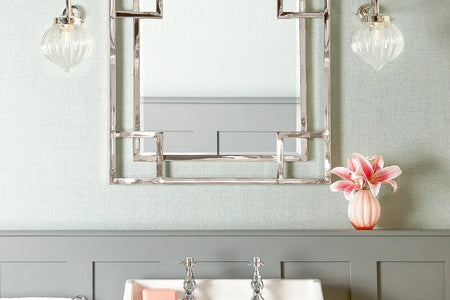
Elegant, opulent and surprisingly eclectic, here's why ravishing Regency interior design is still very relevant in the 21st century...
If you swoon at the sight of a Nash terrace or Brighton’s Royal Pavilion, dream of living in Bath’s Royal Crescent, and have no difficulty visualising yourself in a Jane Austen drawing room, then Regency style is definitely for you. And lest anyone should think that eclectic interior design is a modern phenomenon, Regency designers were busy creating an eclectic style 200 years ago. It may be two centuries old but, as we’ll show you, the Regency look has been influencing interior design ever since, from the golden days of Hollywood to contemporary English country cottages. We’ll take you on the Regency journey and share a special selection of Pooky lighting that would perfectly complement today’s Regency-inspired interiors.
The Royal Crescent, Bath
Regency style – fine and dandy
Strictly speaking the Regency period in England dates from 1810-11 to 1820 but, as with other design styles and movements, the beginning and end of the period is a little more fluid; it coincided with the Biedermeier style in German-speaking countries, America’s Federal style, and, just across the Channel, French Empire style – and its hallmark was elegance, with a touch of flamboyance.
A French Empire style salon. Image credit.
But we can’t consider Regency interior design without first looking at the architecture that it was designed to grace. Regency buildings formed the final phase of Georgian architecture, which had been transforming the wealthier parts not only of London but of other cities and towns, including Bath, Buxton, Cheltenham, the Bristol suburb of Clifton, Royal Leamington Spa and Newcastle-upon-Tyne since the 1700s. While Georgian elements still featured, Regency buildings were influenced by a range of styles, including Egyptian, Gothic, classical Greek and Roman, and Indian. We’ve already mentioned those Nash terraces and the Royal Crescent but there were churches, public buildings, and grand country houses too, such as the Neo-Mughal Sezincote House, designed by Samuel Pepys Cockerell for his brother, Charles (distantly related to the more famous, Samuel P.) Brighton’s Royal Pavilion, designed by John Nash for the Prince Regent, boasted an Indian exterior and Frederick Grace’s Chinese-influenced interiors.
Royal Pavilion, Brighton
The flamboyance that typified Regency style can be attributed in part to the end of the long Napoleonic Wars in 1815. The wars had put economic constraints on public and private spending and had created a continuing shortage of raw materials. With the end of hostilities, the economy picked up, fuelling a new-found self confidence that found expression in all things Regency.Regency interior style – the essential elements

Harewood House, Yorkshire
Regency furniture was all about wood, not just traditional hardwoods such as oak, mahogany and walnut but new, exotic hardwoods - rosewood and tulip wood, for example – which were becoming more readily available.
State Dining Room, Apsley House (Image: English Heritage)
Lines were curved, as can be seen in the fashionable sabre leg chairs, with their echo of the battlefield; caned seats became popular, as did lion’s paw feet, and dining tables with tilting tops. There were cushions galore and sofas – which now came in pairs - often featured bolsters at each end. Why have just one sofa or bolster when you can have two? This walnut daybed, dating from 1815, bears all the hallmarks of Regency furniture: French Empire style, with Egyptian Revival touches, cushions and bolsters, and a demilune canopy.

Regency style sabre leg chair, with requisite striped upholstery (Image credit.) Walnut Egyptian Revival daybed (Image credit)
Striped wallpaper was seen as de rigueur in the smartest houses, and textiles such as damask and chintz were similarly striped. And, for the first time, elegant rooms boasted matching curtains and upholstery fabric.

The Striped Drawing Room, Apsley House; the Piccadilly Drawing Room, Apsley House (Image: English Heritage)
Lead and brass were increasingly used for architectural ironmongery; furniture often incorporated brass inlays, and marble table tops were everywhere.
Regency style reeded brass door handles. Image credit.
Regency style for now
So you’re drawn to Regency style but not sure how to make it work in a 21st century interior. Allow these interiors by the brilliant Rebecca Hughes to inspire you. They combine the opulence of Regency – chandeliers, marble effects, ornate architectural ironmongery, elaborate cornicing, magnificent mirrors, fluted columns and even statuary – with more muted, contemporary colour palettes. Gorgeous!


Images: Rebecca Hughes
Regency style lighting – Pooky shows you how
To bring a touch of Regency to your home lighting scheme, think glass and brass – you can’t go wrong.Bedazzling chandeliers
Well, you can’t have Regency without at least one chandelier. Our larger Rita chandelier has gentle Regency curves and gorgeous blown glass droplets. Sumptous and elegant, without being over the top – perfect for the modern Regency sitting room or rather grand bedroom. Browse all Pooky chandeliers here.
Making an entrance
 Connie
Connie
Light up your hallway – and impress your guests – with a glass and brass pendant along the lines of Pooky’s Connie – contemporary but with more than a hint of Regency extravagance about it.
Don’t forget the walls
There’s something about a carefully chosen wall light that is… oh so Regency. Pooky has a range of glass and brass wall lights, and we think that a classic curved brass fitting with a small but beautifully formed glass shade - like this Shanty fitting with a Scallop shade - would enhance any Regency inspired wall. More in our series 'Classic interior design styles and how to light them': 1. Mid-Century Modern 2. English Country House style 3. Industrial style 4. Eclectic style 5. Coastal style 6. Scandinavian style 7. Art Deco 8. French chic 9. Shabby chic 10. Zen 11. Modern Rustic 12. Bohemian 13. Shaker style 14. Gustavian 15. Arts & Crafts











